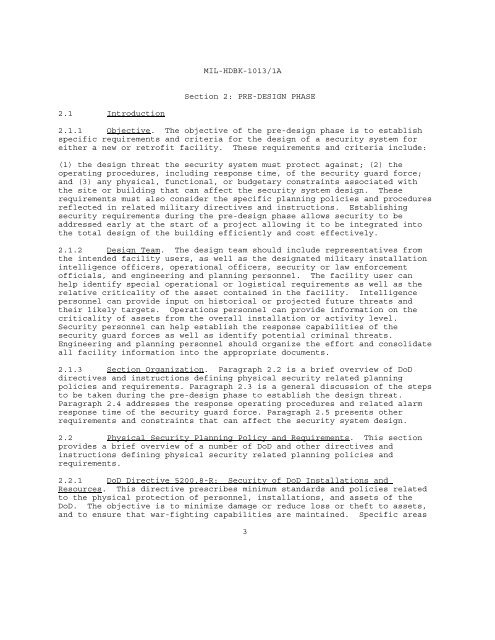MIL-HDBK-1013/1A Design Guidelines for Physical Security of ...
MIL-HDBK-1013/1A Design Guidelines for Physical Security of ...
MIL-HDBK-1013/1A Design Guidelines for Physical Security of ...
You also want an ePaper? Increase the reach of your titles
YUMPU automatically turns print PDFs into web optimized ePapers that Google loves.
2.1 Introduction<br />
<strong>MIL</strong>-<strong>HDBK</strong>-<strong>1013</strong>/<strong>1A</strong><br />
Section 2: PRE-DESIGN PHASE<br />
2.1.1 Objective. The objective <strong>of</strong> the pre-design phase is to establish<br />
specific requirements and criteria <strong>for</strong> the design <strong>of</strong> a security system <strong>for</strong><br />
either a new or retr<strong>of</strong>it facility. These requirements and criteria include:<br />
(1) the design threat the security system must protect against; (2) the<br />
operating procedures, including response time, <strong>of</strong> the security guard <strong>for</strong>ce;<br />
and (3) any physical, functional, or budgetary constraints associated with<br />
the site or building that can affect the security system design. These<br />
requirements must also consider the specific planning policies and procedures<br />
reflected in related military directives and instructions. Establishing<br />
security requirements during the pre-design phase allows security to be<br />
addressed early at the start <strong>of</strong> a project allowing it to be integrated into<br />
the total design <strong>of</strong> the building efficiently and cost effectively.<br />
2.1.2 <strong>Design</strong> Team. The design team should include representatives from<br />
the intended facility users, as well as the designated military installation<br />
intelligence <strong>of</strong>ficers, operational <strong>of</strong>ficers, security or law en<strong>for</strong>cement<br />
<strong>of</strong>ficials, and engineering and planning personnel. The facility user can<br />
help identify special operational or logistical requirements as well as the<br />
relative criticality <strong>of</strong> the asset contained in the facility. Intelligence<br />
personnel can provide input on historical or projected future threats and<br />
their likely targets. Operations personnel can provide in<strong>for</strong>mation on the<br />
criticality <strong>of</strong> assets from the overall installation or activity level.<br />
<strong>Security</strong> personnel can help establish the response capabilities <strong>of</strong> the<br />
security guard <strong>for</strong>ces as well as identify potential criminal threats.<br />
Engineering and planning personnel should organize the ef<strong>for</strong>t and consolidate<br />
all facility in<strong>for</strong>mation into the appropriate documents.<br />
2.1.3 Section Organization. Paragraph 2.2 is a brief overview <strong>of</strong> DoD<br />
directives and instructions defining physical security related planning<br />
policies and requirements. Paragraph 2.3 is a general discussion <strong>of</strong> the steps<br />
to be taken during the pre-design phase to establish the design threat.<br />
Paragraph 2.4 addresses the response operating procedures and related alarm<br />
response time <strong>of</strong> the security guard <strong>for</strong>ce. Paragraph 2.5 presents other<br />
requirements and constraints that can affect the security system design.<br />
2.2 <strong>Physical</strong> <strong>Security</strong> Planning Policy and Requirements. This section<br />
provides a brief overview <strong>of</strong> a number <strong>of</strong> DoD and other directives and<br />
instructions defining physical security related planning policies and<br />
requirements.<br />
2.2.1 DoD Directive 5200.8-R: <strong>Security</strong> <strong>of</strong> DoD Installations and<br />
Resources. This directive prescribes minimum standards and policies related<br />
to the physical protection <strong>of</strong> personnel, installations, and assets <strong>of</strong> the<br />
DoD. The objective is to minimize damage or reduce loss or theft to assets,<br />
and to ensure that war-fighting capabilities are maintained. Specific areas<br />
3

















